

Wiki: Man-Eating Animals. Pumapard. Pumapard, c.1900 Pumapard, Rothschild Museum, Tring A pumapard is a hybrid of a puma and a leopard.
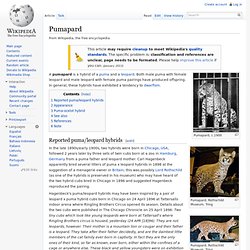
Both male puma with female leopard and male leopard with female puma pairings have produced offspring. In general, these hybrids have exhibited a tendency to dwarfism. Reported puma/leopard hybrids[edit] In the late 1890s/early 1900s, two hybrids were born in Chicago, USA, followed 2 years later by three sets of twin cubs born at a zoo in Hamburg, Germany from a puma father and leopard mother. Jimmy Carter rabbit incident. 1979 incident in which Jimmy Carter was attacked by a swamp rabbit April 20, 1979 White House photo of Carter and rabbit from the Carter Library The Jimmy Carter rabbit incident, sensationalized as a "killer rabbit attack" by the press, involved a swamp rabbit that swam toward then–U.S.

President Jimmy Carter's fishing boat on April 20, 1979. The incident caught the imagination of the media after Carter's press secretary, Jody Powell, mentioned the event to a correspondent months later. Background[edit] United States presidential pets. This is a list of pets belonging to United States Presidents and their families, while serving their term(s) in office.[1] History of White House dogs[edit] Richard Nixon was accused of hiding a secret slush fund during his candidacy for vice president under Dwight D.
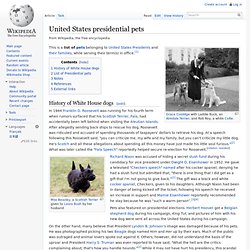
Eisenhower in 1952. He gave a televised "Checkers speech" named after his cocker spaniel; denying he had a slush fund but admitted that, "there is one thing that I did get as a gift that I'm not going to give back.”[2] The gift was a black and white cocker spaniel, Checkers, given to his daughters. Bummer and Lazarus. The Three Bummers.
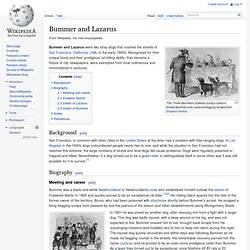
Edward Jump's cartoon shows Bummer and Lazarus begging scraps from Emperor Norton. Bummer and Lazarus were two stray dogs that roamed the streets of San Francisco, California, USA, in the early 1860s. Irukandji jellyfish. Irukandji jellyfish (/ˌɪrəˈkændʒi/ IRR-ə-KAN-jee) are small and extremely venomous box jellyfish that inhabit marine waters of Australia and which are able to fire their stingers into their victim, causing symptoms collectively known as Irukandji syndrome.

Their size is roughly a cubic centimetre (1 cm3). There are four known species of Irukandji: Carukia barnesi, Malo kingi, Alatina alata and the recently discovered Malo maximus.[1][2] The symptoms of Irukandji syndrome were first documented by Hugo Flecker in 1952.[3] They were named after the Irukandji people whose country stretches along the coastal strip north of Cairns, Queensland.[4] The first of these jellyfish, Carukia barnesi, was identified in 1964 by Jack Barnes; in order to prove it was the cause of Irukandji syndrome, he captured the tiny jelly and allowed it to sting him while his son and a lifeguard observed the effects.[5][6] Range[edit] Rin Tin Tin. Famous German Shepherd dog Rin Tin Tin (often hyphenated as Rin-Tin-Tin; September 1918 – August 10, 1932) was a male German Shepherd that was an international star in motion pictures.
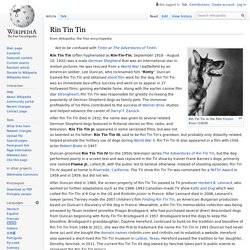
He was rescued from a World War I battlefield by an American soldier, Lee Duncan, who nicknamed him "Rinty". Duncan trained Rin Tin Tin and obtained silent film work for the dog. Rin Tin Tin was an immediate box-office success and went on to appear in 27 Hollywood films, gaining worldwide fame. Along with the earlier canine film star Strongheart, Rin Tin Tin was responsible for greatly increasing the popularity of German Shepherd dogs as family pets.
Duncan groomed Rin Tin Tin IV for the 1950s television series The Adventures of Rin Tin Tin, but the dog performed poorly in a screen test and was replaced in the TV show by trainer Frank Barnes's dogs, primarily one named Flame Jr., called JR, with the public led to believe otherwise. Kraken. Legendary sea monster The kraken ()[1] is a legendary sea monster of gigantic size and cephalopod-like appearance in Scandinavian folklore.

According to the Norse sagas, the kraken dwells off the coasts of Norway and Greenland and terrorizes nearby sailors. Authors over the years have postulated that the legend may have originated from sightings of giant squids that may grow to 13–15 meters (40–50 feet) in length. The sheer size and fearsome appearance attributed to the kraken have made it a common ocean-dwelling monster in various fictional works.
Baculum. Baculum of a dog's penis, arrow shows the urethral sulcus.
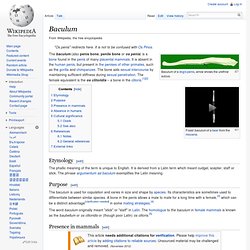
Humanzee. Donnie (dog) Donnie is a Doberman Pinscher dog who came to the attention of science due to his penchant for arranging his plush toys in geometric forms.[1] His owner rescued him from an animal shelter, and at first he was slow to learn, and very reluctant to interact socially with her.[2] He has appeared on the National Geographic Channel’s Dog Genius show.[1][3] On the show, he is shown arranging some of his 80 plush toys into evenly-spaced triangles and lines, and chooses to use, for example, only stuffed frogs or monkeys for a particular design.[4] He is shown creating his arrangements in his large yard in Maryland on remote video cameras without humans being present.

He is even said to create social vignettes with the toys.[4][5] For example, the day after he first allowed his owner to put her arm around him, he placed a large bear with its arm around a smaller frog.[2][6] Dr. Self-awareness - in animals. Self-awareness is the capacity for introspection and the ability to recognize oneself as an individual separate from the environment and other individuals.[1] It is not to be confused with consciousness in the sense of qualia.
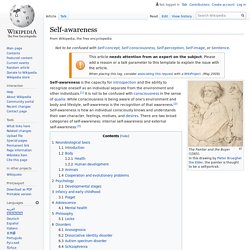
While consciousness is being aware of one's environment and body and lifestyle, self-awareness is the recognition of that awareness.[2] Self-awareness is how an individual consciously knows and understands their own character, feelings, motives, and desires. Falling cat problem. A falling cat modeled as two independently rotating parts turns around while maintaining zero net angular momentum The falling cat problem is a problem that consists of explaining the underlying physics behind the observation of the cat righting reflex: that is, how a free-falling body (cat) can acquire angular momentum such that it is able to right itself as it falls to land on its feet, irrespective of its initial orientation, and without violating the law of conservation of angular momentum.
Although amusing and trivial to pose, the solution of the problem is not as straightforward as its statement would suggest. The apparent contradiction with the law of conservation of angular momentum is resolved because the cat is not a rigid body, but instead is permitted to change its shape during the fall owing to the cat's flexible backbone and no functional collar-bone.